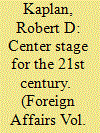|
|
|
Sort Order |
|
|
|
Items / Page
|
|
|
|
|
|
|
| Srl | Item |
| 1 |
ID:
086022


|
|
|
|
|
| Publication |
2009.
|
| Summary/Abstract |
For better or worse, phrases such "the Cold War" and "the clash of civilizations" matter. In a similar way, so do maps. The right map can stimulate foresight by providing a spatial view of critical trends in world politics. Understanding the map of Europe was essential to understanding the twentieth century. Although recent technological advances and economic integration have encouraged global thinking, some places continue to count more than others. And in some of those, such as Iraq and Pakistan, two countries with inherently artificial contours, politics is still at the mercy of geography.So in what quarter of the earth today can one best glimpse the future? Because of their own geographic circumstances, Americans, in particular, continue to concentrate on the Atlantic and Pacific Oceans. World War II and the Cold War shaped this outlook: Nazi Germany, imperial Japan, the Soviet Union, and communist China were all oriented toward one of these two oceans. The bias is even embedded in mapping conventions: Mercator projections tend to place the Western Hemisphere in the middle of the map, splitting the Indian Ocean at its far edges. And yet, as the pirate activity off the coast of Somalia and the terrorist carnage in Mumbai last fall suggest, the Indian Ocean -- the world's third-largest body of water -- already forms center stage for the challenges of the twenty-first century. The greater Indian Ocean region encompasses the entire arc of Islam, from the Sahara Desert to the Indonesian archipelago. Although the Arabs and the Persians are known to Westerners primarily as desert peoples, they have also been great seafarers. In the Middle Ages, they sailed from Arabia to China; proselytizing along the way, they spread their faith through sea-based commerce. Today, the western reaches of the Indian Ocean include the tinderboxes of Somalia, Yemen, Iran, and Pakistan -- constituting a network of dynamic trade as well as a network of global terrorism, piracy, and drug smuggling. Hundreds of millions of Muslims -- the legacy of those medieval conversions -- live along the Indian Ocean's eastern edges, in India and Bangladesh, Malaysia and Indonesia.
|
|
|
|
|
|
|
|
|
|
|
|
|
|
|
|
|
|
|
|
|